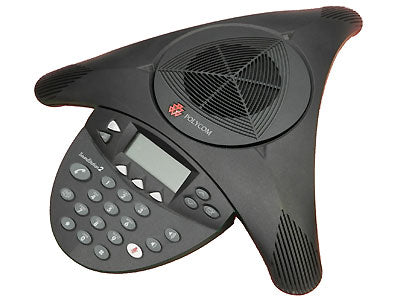The Polycom SoundStation 2 is an analog conference phone built to provide high quality audio conference calls. With Polycom’s Acoustic Clarity Technology and support for dynamic noise reduction, the SoundStation 2 remains one of the most popular conference phones on the market. As an analog conference phone, it uses the G.711 mu-law codec to generate phone conversations, allowing for broad inter-operability.
Is the Polycom SoundStation 2 Right For Me?
The Polycom SoundStation 2 is directly compatible with traditional phone lines when a phone system is not used. These include digital phone lines from a cable provider such as Comcast or Time Warner. As long as the lines support DTMF, the SoundStation 2 will work fine. Additional phone systems such as the Bizfon 680 will support the SoundStation 2 directly.
VoIP phone system users have a choice. These users can either use an IP based conference phone such as the Polycom IP 6000 conference phone. For those looking to save money, the Polycom SoundStation 2 can be hooked up to one of the analog FXS ports commonly found on IP based phone systems. These analog FXS ports are available on the Allworx 6x, Adtran NetVanta 7100, and even many ShoreTel voice switches.
Digital phone systems are an awkward middle ground for many users. A digital phone port is most often an RJ-11 port that looks identical to an analog line. The difference is in how the signals are sent. Phone systems such as Nortel and Avaya are digital and prevent an analog conference phone from directly working. Some phone systems such as the Avaya Definity have a digital conference phone option such as the Avaya 2490, but this is the exception, not the rule.
Those with a Digital system will want to look into using an analog conference phone in a work around setup. There are three options commonly available to those using a digital phone system.
Option 1: Bypass the phone system
The first option is to simply bypass the digital phone system by taking an analog line that would go into the system and plugging it directly into the SoundStation 2. Alternatively, you can have a dedicated analog line outside of the phone system if you plan on needing to use the conference phone frequently. This bypasses the need to make any changes to your system.
Option 2: Use an Analog Port Card
Certain phone systems such as the Inter-Tel Axxess, Mitel CS-5200, Samsung OfficeServ, ESI IVX Class and Communications Servers, and NEC Aspire systems can have an analog station card installed into the phone system to provide analog ports. These analog ports when installed into the system provide generic RJ-11 analog connectivity that support DTMF ringtone and allow the Polycom SoundStation 2 to be used along with other analog devices such as a fax machine. The downside of using an analog port card is the additional cost if you do not already have an analog port card installed. Second, the port the conference phone plugs into will need to be wired to the analog port card to ensure proper connectivity. Once finished, it will be the most professional way to set up the conference phone.
Option 3: Use an XDP (eXtra Digital Port)
Some digital phone systems such as the Panasonic KX-TD series can take advantage of something called a digital extra device port (DXDP). This port allows an analog device to be connect to the same digital port as the digital phone it connects to. This means for those who have an XDP on their digital phone, they can collocate a traditional desk phone along with the Polycom SoundStation 2. An additional phone that can do this is the Avaya Partner 18D.
As you can see, there are many different ways to connect an analog conference phone to your system. The wide compatibility of the Polycom SoundStation 2 will make it popular for years to come. For those looking to add a conference phone to their system, we recommend the SoundStation 2.

